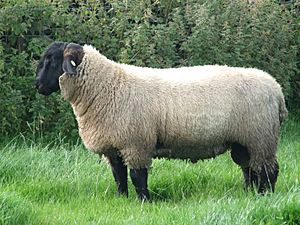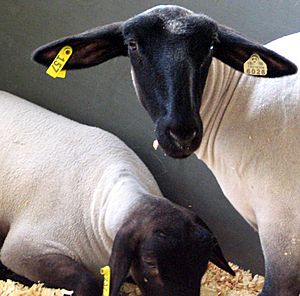Suffolk sheep facts for kids

A seven-month-old ram lamb
|
|
| Conservation status | FAO (2007): not at risk |
|---|---|
| Country of origin | United Kingdom |
| Distribution | world-wide |
| Standard | Suffolk Sheep Society |
| Use | meat |
| Traits | |
| Weight |
|
| Height |
|
| Skin colour | pink |
| Wool colour | white |
| Face colour | black |
| Horn status | polled |
|
|
The Suffolk is a popular type of domestic sheep from Britain. It first appeared in the late 1700s near Bury St Edmunds in Suffolk. This sheep breed was created by mixing two other breeds: Norfolk Horn ewes (female sheep) and improved Southdown rams (male sheep). Suffolk sheep are known for their black faces and legs, and they don't have horns. They are mostly raised for their meat. You can find Suffolk sheep in many countries around the world, making them one of the most common sheep breeds.
Contents
History of the Suffolk Sheep
The Suffolk sheep breed started in the late 1700s. This happened in the area around Bury St Edmunds in Suffolk, England. Farmers created the breed by cross-breeding two different types of sheep. They bred Norfolk Horn ewes with improved Southdown rams.
At first, these new sheep were called "Blackfaces" or "Southdown-Norfolks." The name "Suffolk" was first used for them in 1797. By 1810, people recognized them as a unique breed. However, they didn't get their current name until 1859.
In 1886, a special group called the English Suffolk Society was formed. This group helped keep track of the breed. The next year, they recorded about 15,000 female Suffolk sheep. By the end of the 1800s, Suffolk rams were often used in Scotland to breed with other sheep. This helped create lambs that grew well for meat.
By the 1980s, there were about 500,000 Suffolk sheep in the United Kingdom. However, their numbers later went down.
Suffolk Sheep Around the World
Suffolk sheep have been sent to many countries. These include Australia, Canada, France, Germany, New Zealand, South Africa, and the United States. They have become one of the most common sheep breeds globally.
They arrived in the USA in 1888. A farmer named G.B. Streeter brought them to Chazy, New York. In the USA, a larger, long-legged type of Suffolk sheep has developed. These sheep grow very fast.
Characteristics of Suffolk Sheep
Suffolk sheep are a common type of domestic sheep. They are known for their unique look. They have black faces and black legs, but their bodies are covered in white wool. They do not have horns, which means they are "polled."
Suffolks are considered a large breed of sheep. Their size and coloring come from their Southdown ancestors. Their big bodies and strong muscles make them great for producing meat. They also produce good wool. These sheep are very tough and strong, a trait they inherited from their Norfolk Horn ancestors.
Uses of Suffolk Sheep
Suffolk rams are often used as "terminal sires." This means they are bred with other types of ewes. The lambs produced from these pairings grow quickly and have excellent meat. This makes them very valuable for farmers who raise sheep for meat.
Health Concerns
A health issue called Spider lamb syndrome is sometimes seen in the Suffolk breed. This is a genetic condition that affects the bones and causes lambs to have unusual leg shapes.
See also
 In Spanish: Suffolk (oveja) para niños
In Spanish: Suffolk (oveja) para niños


